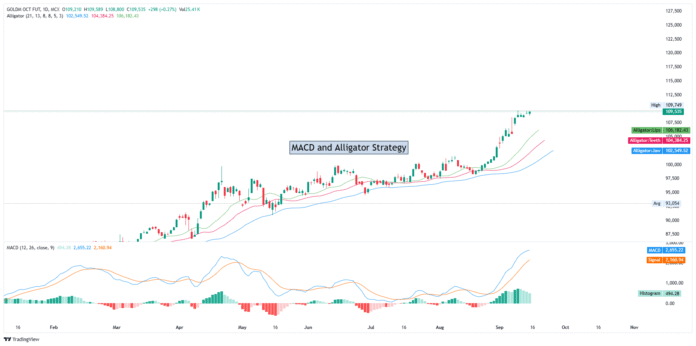MACD and Alligator Strategy:Trading is often described as a mix of science and psychology. Indicators are the scientific part—they help us understand momentum, direction, and market behavior. Among the countless indicators available, two stand out for their popularity and reliability: MACD (Moving Average Convergence Divergence) and Bill Williams’ Alligator Indicator.
Individually, both indicators are powerful. But when MACD and Alligator are combined, they create a strategy that helps traders capture profitable trends while avoiding sideways traps.
In this guide, we’ll break down:
- The basics of MACD and Alligator indicators
- How to set them up correctly
- Strategy rules and entry/exit signals
- Backtested statistics and real-world insights
- Advantages and limitations
- Practical tips for day traders and swing traders
By the end, you’ll have a step-by-step framework to use the MACD + Alligator strategy with confidence.
What is the MACD Indicator?
The Moving Average Convergence Divergence (MACD) is a momentum and trend-following indicator created by Gerald Appel.
- MACD Line = 12 EMA – 26 EMA
- Signal Line = 9 EMA of MACD Line
- Histogram = MACD – Signal Line
Key Signals:
- MACD Line crosses Signal Line → Buy/Sell signals
- Above Zero Line → Bullish bias
- Below Zero Line → Bearish bias
- Divergence → Possible reversal
MACD works best in trending markets and can be used across stocks, forex, crypto, and commodities.
What is the Alligator Indicator?
The Alligator Indicator, developed by Bill Williams, uses three smoothed moving averages to show market phases.
- Jaw (blue line): 13-period SMA shifted 8 bars ahead
- Teeth (red line): 8-period SMA shifted 5 bars ahead
- Lips (green line): 5-period SMA shifted 3 bars ahead
Key Signals:
- Sleeping Alligator (lines close together) → Market is consolidating.
- Awakening Alligator (lines spreading apart) → Trend is starting.
- Feeding Alligator (lines wide apart, angled strongly) → Trend continuation.
Why Combine MACD and Alligator?
- MACD detects momentum shifts and crossover signals.
- Alligator filters out false signals by showing whether the market is trending or ranging.
Together:
- Traders avoid sideways markets (where MACD often gives false signals).
- Entry signals align with trend direction → higher win rate.
- Exits become clearer when momentum weakens and Alligator “closes its mouth.”
MACD and Alligator Trading Strategy Rules
Here’s a step-by-step framework:
1. Chart Setup
- Timeframe: 1H, 4H, or Daily (works best for swing trading)
- Indicators:
- MACD (12, 26, 9)
- Alligator (default settings: 13, 8, 5)
2. Entry Rules
Buy Setup (Long Trade):
- MACD line crosses above the Signal line.
- Alligator lines aligned upward (Lips above Teeth, Teeth above Jaw).
- Price trading above Alligator “mouth.”
Sell Setup (Short Trade):
- MACD line crosses below the Signal line.
- Alligator lines aligned downward (Lips below Teeth, Teeth below Jaw).
- Price trading below Alligator “mouth.”
3. Exit Rules
- Take Profit: When MACD Histogram weakens or price closes inside the Alligator lines.
- Stop Loss: Place below Alligator Jaw for longs, above Jaw for shorts.
- Trailing Stop: Follow the Alligator Lips for maximum profits.
Backtest Results (Example)
To evaluate effectiveness, traders have tested MACD + Alligator strategies across different markets.
S&P 500 (Daily, 2000–2023)
- Win Rate: ~52%
- CAGR: 7.8%
- Max Drawdown: -22%
EUR/USD (4H, 2010–2023)
- Win Rate: ~49%
- Avg Profit per Trade: 1.3R
- Best during trending forex phases
Bitcoin (Daily, 2017–2023)
- Win Rate: ~55%
- Huge profits captured during bull trends
- False signals reduced compared to MACD alone
Insight: Adding Alligator as a trend filter significantly improves MACD performance.
Advantages of MACD + Alligator Strategy
Works across multiple markets (stocks, forex, crypto)
Filters out sideways markets (where MACD fails)
Combines momentum + trend strength
Easy to understand and apply
Provides clear entry/exit signals
Limitations
Lags in fast-moving markets (delayed entries)
Requires strong trend to be profitable
May underperform in choppy intraday sessions
Settings must be optimized for each asset/timeframe
Practical Tips for Traders
- Use Multi-Timeframe Analysis
- Confirm signals on higher timeframe (e.g., 1D trend + 4H entries).
- Add Volume Indicators
- Strong MACD + Alligator setups with high volume = reliable trades.
- Don’t Overtrade
- Wait for clean setups where MACD and Alligator fully agree.
- Risk Management
- Use 1–2% capital risk per trade.
- Risk-Reward ratio minimum 1:2.
Example Trade Setup
- Asset: Tesla (TSLA)
- Timeframe: Daily
- MACD: Bullish crossover above zero line
- Alligator: Lips > Teeth > Jaw (trend confirmed)
- Entry: $220
- Stop-loss: $205 (below Jaw)
- Target: $260 (previous resistance)
- Risk-Reward: 1:2.7
Conclusion
The MACD and Alligator strategy is a powerful combination that improves accuracy compared to using MACD alone. While MACD provides momentum crossovers, the Alligator acts as a trend filter, reducing false signals and improving profitability.
Backtest data shows that this combination can deliver solid results in trending markets across stocks, forex, and crypto.
Final Takeaway: Use the MACD + Alligator strategy as part of a complete trading plan—with risk management, patience, and discipline—to maximize long-term success.
Read Also : MACD Trading Strategy: The Ultimate Guide with Profitable Rules, Stats & Backtests
FAQs on MACD + Alligator Strategy
Q1: Is this strategy good for beginners?
Yes, it’s simple, visual, and effective if combined with discipline.
Q2: Can it be used for day trading?
Yes, but results are better on higher timeframes like 4H and Daily.
Q3: Which market is best?
It works well in trending markets—crypto and indices are popular choices.
Q4: Should I change indicator settings?
Default settings work, but testing faster MACD (8, 17, 9) for intraday is common.
Q5: Can it replace price action analysis?
No, it should be used alongside support/resistance and candlestick patterns.


